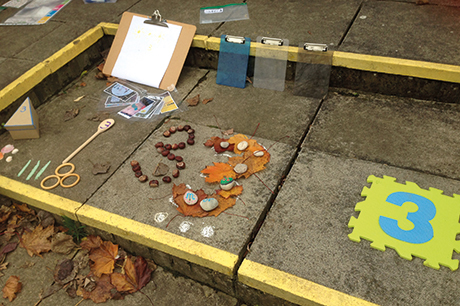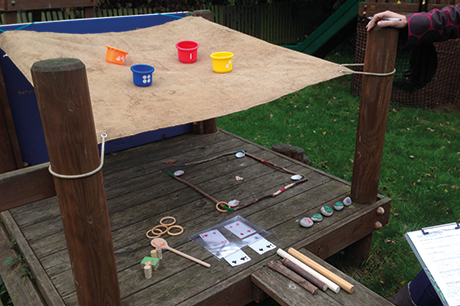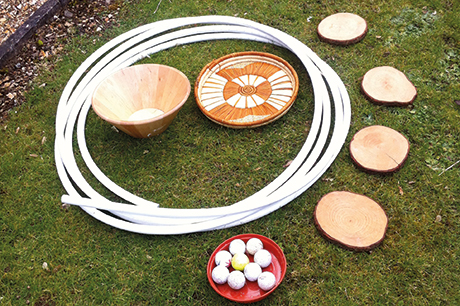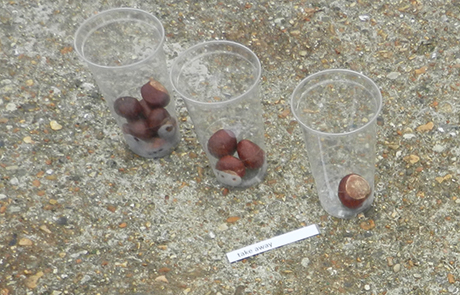
Download the PDF of this article
Outdoors is an excellent context for exploring maths. Enabling children to collect their own resources, and use movement as part of the learning, helps them to understand and embed the concepts.
1 THE POWER OF 3 (OR 4, 5…)
 Understanding place value and learning to subitise are crucial counting skills. Use the child’s own age – a number they are likely to recognise in written form – as the launch point for collecting as many matching sets of objects and making as many variations of that number as they can. Group the children by age so they work as a group of that number.
Understanding place value and learning to subitise are crucial counting skills. Use the child’s own age – a number they are likely to recognise in written form – as the launch point for collecting as many matching sets of objects and making as many variations of that number as they can. Group the children by age so they work as a group of that number.
As well as depictions of the number itself, children could make collections of the number, build the number from subsets of the number (for example, three twigs, three conkers and three leaves to build a large number 3).
Provide resources such as string and chalk so children can emphasise shapes, collections or structures they have made.
2 SCAVENGE AND SORT
Old cutlery trays make excellent sorting boxes. Again, make use of children’s natural curiosity, and encourage them to curate scavenged collections in the trays – either of their own choosing or with a prompt from you, such as ‘shades of green’, ‘round objects’ or ‘five of anything’. Once the children have filled their trays, discuss the similarities and differences. Talk about where they found the objects, count the objects, and group everyone’s objects by size, colour, shape and/or quantity.
3 MATHS LANGUAGE
My ‘sparky words’ crib sheet (Download PDF here) includes more than 200 common maths words to print off, laminate and chop up. Words range from ‘2D’ and ‘zero’ to ‘minute’ and ‘heavy’.
Next time you head outdoors, pop a random handful of laminated sparky words in your pocket. Each time your hand reaches in, pull one out to use as a prompt to generate mathematical conversation, or to simply to reflect on how children are already using maths words and concepts in their free play.
4 SEQUENCING STORIES
Many story books lend themselves to mathematical thinking, but one of my favourites is We’re Going on a Bear Hunt. The rhythmic text encourages a walking or talking beat and the narrative has a distinct counting up and back arc.
Find an old copy of your chosen book, separate the pages and laminate them. There are many ways to use the new ‘outdoor’ version:
- Leave it in a role-play area.
- Separate the pages so children have to collect and sequence them correctly.
- Hide some pages and ask the children what’s missing.
- Encourage children to sequence the pages and write on the page numbers with dry-wipe markers.
5 TAKE-AWAY CONKERS
Explore the concept of number bonds by using clear plastic cups and conkers.
Line up three cups.
Offer children a simple addition sum to begin with (for example, 1 + 2). Children should place one conker in the first cup and two in the second, then count these and place three in the third cup.
Now walk around the cups to the opposite side and ‘read’ the sum from left to right again. This time you have three conkers, two conkers and one conker. Discuss the new sum: ‘Three conkers take away two equals one conker.’
Let the children experiment with ten conkers, moving around to see the ‘opposite’ sum each time.
And another thing…
Build your knowledge and confidence with books such as:
- The Building Blocks of Early Maths by Elaine Bennett and Jenny Weidner
- Messy Maths by Juliet Robertson
- The Little Book of Maths from Stories by Neil Griffiths
- Every Child a Mover by Jan White
- 100 Ideas: Outdoor Play by Julie Mountain









